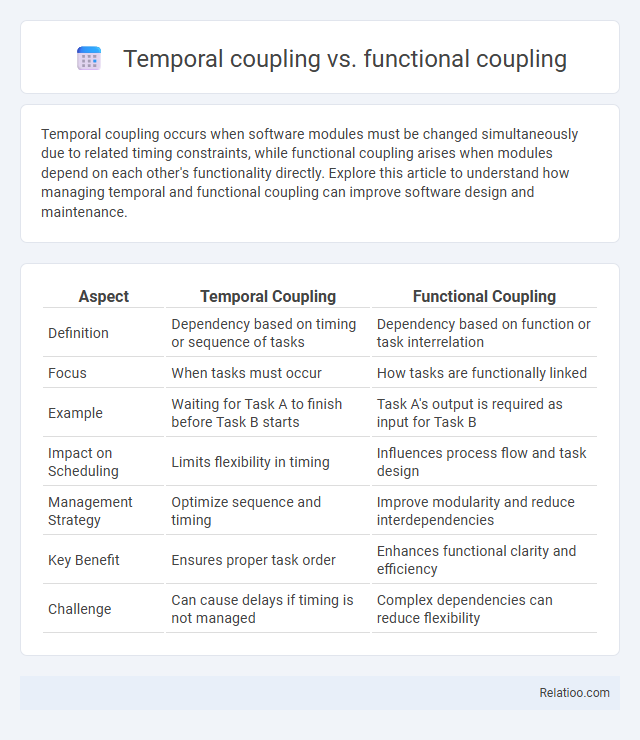Temporal coupling occurs when software modules must be changed simultaneously due to related timing constraints, while functional coupling arises when modules depend on each other's functionality directly. Explore this article to understand how managing temporal and functional coupling can improve software design and maintenance.
Table of Comparison
| Aspect | Temporal Coupling | Functional Coupling |
|---|---|---|
| Definition | Dependency based on timing or sequence of tasks | Dependency based on function or task interrelation |
| Focus | When tasks must occur | How tasks are functionally linked |
| Example | Waiting for Task A to finish before Task B starts | Task A's output is required as input for Task B |
| Impact on Scheduling | Limits flexibility in timing | Influences process flow and task design |
| Management Strategy | Optimize sequence and timing | Improve modularity and reduce interdependencies |
| Key Benefit | Ensures proper task order | Enhances functional clarity and efficiency |
| Challenge | Can cause delays if timing is not managed | Complex dependencies can reduce flexibility |
Introduction to Software Coupling
Software coupling measures the degree of interdependence between software modules, impacting maintainability and flexibility. Temporal coupling occurs when modules must be executed in a specific sequence, while functional coupling involves modules sharing data or functionality directly. Understanding these coupling types helps developers design modular, loosely coupled systems to enhance code reuse and reduce complexity.
Defining Temporal Coupling
Temporal coupling occurs when components or functions must interact or execute in a specific time sequence, making system behavior dependent on timing constraints. Functional coupling refers to the degree to which one module relies on another through shared functions or operations, whereas coupling generally describes the overall interdependencies between modules. Understanding temporal coupling is crucial for designing systems with better modularity and reducing timing-related integration issues.
Defining Functional Coupling
Functional coupling refers to the degree to which different functions or modules within a software system depend on each other to perform tasks, emphasizing the flow of data and control between them. Temporal coupling occurs when modules must be executed in a specific sequence or time frame, regardless of their functional independence. Understanding functional coupling is crucial for designing modular, maintainable systems by minimizing dependencies that hinder reuse and testing.
Key Differences Between Temporal and Functional Coupling
Temporal coupling occurs when modules interact based on timing or sequence, requiring certain operations to happen in a specific order, whereas functional coupling involves modules sharing data or functionality directly to complete tasks. Your system's maintainability improves by minimizing temporal coupling since it reduces dependencies tied to execution order, while functional coupling focuses more on the nature of the data or functions exchanged. Understanding these distinctions helps optimize module interaction, leading to cleaner, more modular code and easier debugging.
Impacts of Temporal Coupling on Code Maintainability
Temporal coupling occurs when code components must be executed in a specific order, creating dependencies that hinder flexibility and increase the difficulty of making changes. Unlike functional coupling, which relates to data and functional dependencies, temporal coupling forces your maintainers to understand and preserve execution sequences, leading to higher risks of introducing errors during updates. Reducing temporal coupling improves code maintainability by enabling easier refactoring and adaptation to new requirements without breaking dependent processes.
Effects of Functional Coupling on System Design
Functional coupling involves dependencies between modules based on shared functions, impacting system design by increasing complexity and reducing modularity, which can lead to higher maintenance costs and difficulty in testing. Temporal coupling occurs when modules must be executed in a specific sequence, often affecting system flexibility and scalability. Understanding the differences between temporal coupling, functional coupling, and general coupling enables you to design systems that minimize interdependencies, enhancing robustness and facilitating easier updates.
Common Causes of Temporal Coupling
Temporal coupling occurs when components or functions must be executed in a specific order due to timing dependencies, often caused by shared resources or side effects. Functional coupling refers to the relationship where one module directly depends on the functionality of another, impacting reusability and maintainability. Common causes of temporal coupling include reliance on external state changes, sequential workflow requirements, and improper synchronization mechanisms, which can hinder Your system's flexibility and increase the risk of errors.
Identifying Functional Coupling in Codebases
Functional coupling occurs when different parts of a codebase depend on each other to perform specific tasks or features, making it essential for understanding code maintainability and modularity. You can identify functional coupling by analyzing dependencies between functions or modules that work together to achieve a particular functionality, often revealed through shared data flows or direct function calls. Reducing functional coupling enhances code clarity and simplifies updates by isolating functions responsible for distinct operations.
Best Practices to Minimize Temporal and Functional Coupling
Minimizing temporal coupling involves designing systems with asynchronous interactions and well-defined event-driven architectures, enabling components to operate independently without strict timing dependencies. Best practices for reducing functional coupling emphasize creating modular interfaces with clear abstractions and single-responsibility principles, ensuring components communicate through minimal and stable contracts. Effective decoupling improves maintainability, scalability, and robustness by isolating changes and reducing the ripple effects of modifications across system components.
Conclusion: Choosing the Right Coupling Strategy
Selecting the right coupling strategy depends on Your project's goals and system design requirements. Temporal coupling, which links components based on timing, suits scenarios needing synchronized processes, while functional coupling emphasizes interdependent functionalities for cohesive module interactions. Understanding the trade-offs between loose and tight coupling enables optimized maintainability, scalability, and performance tailored to Your software architecture.

Infographic: Temporal Coupling vs Functional Coupling
 relatioo.com
relatioo.com